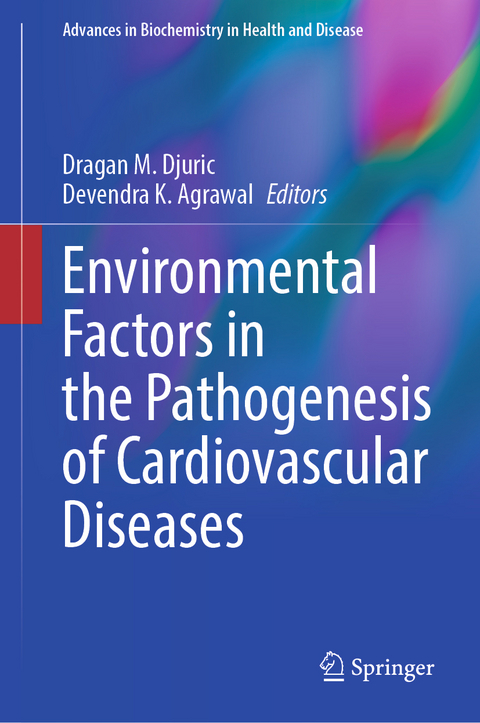
Environmental Factors in the Pathogenesis of Cardiovascular Diseases
Springer International Publishing (Verlag)
978-3-031-62805-4 (ISBN)
Environmental conditions and processes are one of the major pillars on which the human well-being rests. It is the core responsibility of the society to preserve and enhance better conditions for the human well-being. Indeed, there are several evolving unmet needs in public health. Emerging and re-emerging infectious diseases and a surge in the incidence of non-communicable diseases, including cardiovascular diseases (CAD), chronic respiratory diseases, and metabolic diseases have been impediments to sustainable well-being.
Many factors are critical in the global surge in the rate and incidence of cardiovascular diseases. These include the shift from acute to chronic conditions, the shift from single risk factor vs. multiple influences, aging population, global health disparities, exposure to lower harmful influences over a longer period, etc. However, the epigenetic factors due to unhealthy environment play a most significant role in the underlying pathogenesis of cardiovascular diseases. Unfortunately, this has been ignored for a long time and realized lately to expand and disseminate knowledge to general population, expand research activities to investigate the cellular and molecular mechanisms, and develop better preventive and treatment strategies.
The most significant environmental impoverishment in the pathogenesis of cardiovascular diseases include different genetical, chemical, physical, and biological influences, but not limited to, socio-economic status and lack of nutrients, nutritional aspects including habits, diets and additives, inhaled and ingested pollutants, exhaust gas and gasoline products, tobacco smoke, water pollution, alcohol consumption, soil and mineral pollution, solvents, pesticides, microplastics, non-critical usage of drugs, climate change, extreme atmospheric conditions, extremes in noise and temperature, electromagnetic influences, microwaves and radiation, outdoor light pollution, mental stressors, lack of or over exercise, microbiota and microbiological agents like SARS CoV-2 virus, etc.
Part 1. Introduction.- 1. Introduction Dragan M. Djuric and Devendra K. Agrawal (Serbia, US).- 2. Human envirome and cardiovascular diseases Professor Kristina Gopcevic and Team (Serbia).- Part2. Environmental Aspects in the Pathogenesis of Cardiovascular Diseases.- 3. Endocrine disruptors and cardiovascular diseases: a thinly veiled threat Professor Danina M. Muntean and Team (Romania).- 4. Cardiovascular disease risk factors, immune checkpoints and Tregs Professor Xiaofeng Yang and Team (US).- 5. Toxic effects of intracellular free zinc ion in cardiomyocytes via zinc-transporters: Structural and functional changes in mitochondria Professor Belma Turan and Team (Turkey).- 6. Cardiovascular effects of acetylcholinesterase inhibitors Professor Milos Stojiljkovic and Team (Bosnia and Herzegovina).- 7. Cardiotoxic effects of catecholamines Professor Milos Stojiljkovic and Team (Bosnia and Herzegovina).- 8. Pathophysiological mechanisms of COVID infection in diabetes Professor Dinender K. Singla and Team (US).- 9. Magnetic fields and cardiovascular health Professor Nina Japundzic Zigon and Team (Serbia).- 10. Seasonality of cardiovascular diseases: Roles of natural and anthropogenic factors Professor Leonid P. Churilov and Team (Russia).- 11. Environmental factors and CABG grafts: histophysiology and strategies for grafts patency rate improvement Professor Milica Labudovic Borovic and Team (Serbia).- 12. Is homocysteine biomarker of epigenetic-DNA methylation and environmental health risk: Roles in cardiovascular pathophysiology and link with homocysteine-related vitamins? Professor Dragan M. Djuric and Team (Serbia).- 13. Mental stressors and cardiovascular diseases Professor Antoinette Oliveira Blackman (Brazil).- 14. Air pollution and the pathogenesis of CVD -to be determined.- 15. Water pollution and the pathogenesis of CVD -to be determined.- Part 3. Genetics and Nutritional Effects in the Pathogenesis of Cardiovascular Diseases.- 16. Interaction between Genetic Factors and Environmental Factors in the Pathogenesis of CVD Professor Devendra K. Agrawal and Team (US).- 17. Nutrition, Gut Microbiota, and the Pathogenesis of Cardiovascular Diseases to be determined.- Part 4. Prevention of Environmental Factors-induced Cardiovascular Diseases.- 18. Recent trends and advancements in the pathogenesis and prevention of cardiovascular diseases: With special focus on the mitigation of oxidative stress, atherosclerosis, and gut microbiota-induced trimethylamine Professor Harpal Buttar and Team (Hungary).- 19. The role of exercise in the CVD prevention Professor Dr. Maciej Banach (Poland).- 20. Cardiovascular adaptation to exercise: from basic science to applied investigations Professor Vladimir Jakovljevic and Team (Serbia).- 21. French paradox: a role for Akt activation Professor Ferenc Gallyas Jr, and Team (Hungary).- Part 5. Treatment of Environmental Factors-induced Cardiovascular Diseases.- 22. Potential new drug targets modulating the environmentally induced oxidative stress in the cardiovascular system Professor Zoran Todorovic and Team (Serbia).- 23. Critical Therapeutic Targets of Human Cardiac Infarction Pathology - Methods to Aid the Adult Hypoxic Heart Professor Ildiko Bock-Marquette and Team (Hungary).- 24. Angiotensin Converting Enzyme-2 (ACE-2): A target for Novel Drug Development Professor Ramesh K. Goyal and Team (India).- 25. The role of pharmacogenomics in drug-induced cardiovascular toxicity Professor Ranko Skrbic (Bosnia and Herzegovina).- 26. Anti-inflammatory therapy and pleiotropic effects of drugs Professor Devendra K. Agrawal and Team (US).
| Erscheinungsdatum | 03.08.2024 |
|---|---|
| Reihe/Serie | Advances in Biochemistry in Health and Disease |
| Zusatzinfo | XVIII, 720 p. 46 illus., 39 illus. in color. |
| Verlagsort | Cham |
| Sprache | englisch |
| Maße | 155 x 235 mm |
| Themenwelt | Naturwissenschaften ► Biologie |
| Schlagworte | Cardiovascular Diseases • cardiovascular health • Environmental Factors • exercise • Pharmacogenomics • pollution • risk factors • therapeutic targets |
| ISBN-10 | 3-031-62805-5 / 3031628055 |
| ISBN-13 | 978-3-031-62805-4 / 9783031628054 |
| Zustand | Neuware |
| Informationen gemäß Produktsicherheitsverordnung (GPSR) | |
| Haben Sie eine Frage zum Produkt? |
aus dem Bereich


